Reference levels: Concepts, functions, and application in REDD+ and forest carbon standards
Summary
Results-based payments for REDD+ efforts will require measurement and quantification of performance—and therefore, the construction of reference levels (RLs). RLs set a performance benchmark for mitigation activities by providing a reference point, or baseline to which current and actual efforts can be compared throughout a pre-determined timeframe. Consequently, RLs are strongly linked to measurement, reporting, and verification (MRV) of mitigation efforts.
The establishment of RLs is required by a number of standards and initiatives that promote the reduction of deforestation and forest degradation and the role of conservation, sustainable management of forests and enhancement of forest carbon stocks in developing countries (REDD+) and mitigation activities in the land-use sector in general. REDD+ and forest RLs are comprised of a common set of substantive elements (e.g., scope of activities, scale of accounting, carbon pools included, and methodologies) and procedural elements (e.g., submission, approval, review, and underlying procedural principles).
Looking at how these common substantive and procedural design features are structured under each regime can help clarify particular functions of RLs and place the RL discussion in an appropriate context. This paper seeks to assess how different results-based initiatives deal with common RL design problems in order to inform REDD+ negotiations and policy makers. It is also intended to serve as a reference for a consolidated overview of options for constructing RLs, and enhance understanding of how their different forms and function will impact the overall design of REDD+ mechanisms.


 Twitter
Twitter Google+
Google+ Facebook
Facebook LinkedIn
LinkedIn Digg
Digg del.icio.us
del.icio.us StumbleUpon
StumbleUpon